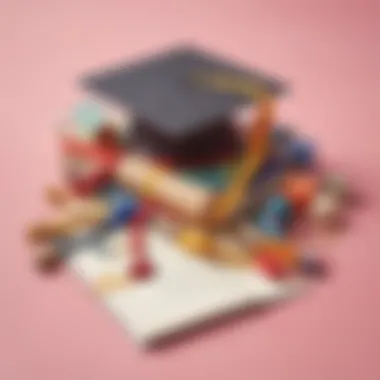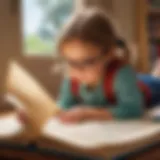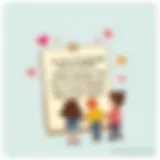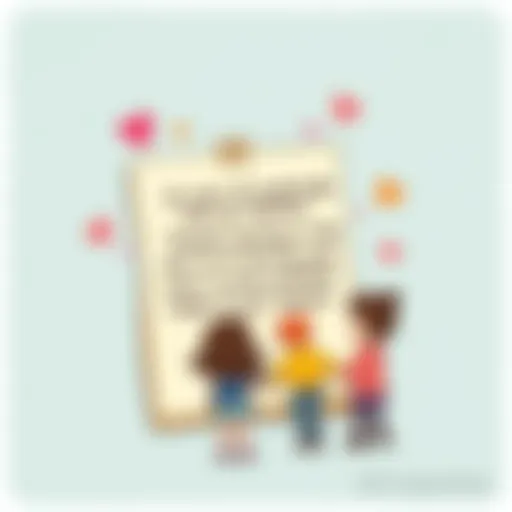Crafting Meaningful Preschool Graduation Cards


Intro
Preschool graduation is a pivotal moment in the lives of young children and their families. It marks the transition from early learning environments to foundational educational settings. Preschool graduation cards serve not just as a symbol of this milestone, but also as a keepsake that parents, educators, and children can cherish. These cards encapsulate memories, offering a glimpse into the child's journey of growth and learning, while also promoting creativity and connection.
In this guide, we will examine the various aspects of preschool graduation cards including their significance, design elements, personalization options, and the heartfelt messages that often accompany them. Each section aims to amplify the understanding of how these cards can serve important roles in a child’s developmental milestones.
Significance of Graduation Cards
Graduation cards are not merely decorative objects. They carry emotional weight and symbolize achievements. For children, receiving a graduation card can boost confidence and self-esteem. It serves as a public acknowledgment of their efforts and learning over the years.
"A graduation card can represent a step forward, a bridge to future educational experiences."
For parents and educators, these cards act as tangible reminders of a child’s early accomplishments. They can reflect what the child has learned and experienced in preschool, presenting a collective reflection on growth and discovery.
Elements of Design
Designing a preschool graduation card can be a delightful endeavor. Key elements that contribute to a captivating card include:
- Color Palette: Vibrant colors often resonate with children. Choose hues that evoke fun and joy.
- Illustrations: Incorporating cartoon characters or illustrations of graduation caps can make cards more appealing.
- Fonts: Opt for playful, readable fonts. They should be easy to understand for both children and adults.
The balance between aesthetic elements and meaningful content is essential. The aim is to ensure the card effectively represents the celebration while resonating with the young recipient.
Personalization Options
To make a graduation card special, consider various personalization options. Personal touches can include:
- Child's Name: Incorporate the child's name prominently.
- Photos: Use a recent photo of the child in their graduation attire.
- Messages from Family: Write heartfelt notes or messages to add depth to the card.
By allowing these personalization strategies, the card transforms into a unique memento that reflects the child's individual journey.
Crafting Heartfelt Messages
Crafting a message for a graduation card is a crucial task. The message should be sincere and supportive, highlighting achievements and looking forward to future endeavors. Here are a few tips:
- Keep It Simple: Use clear, simple language that resonates with young readers.
- Acknowledge Achievements: Mention specific achievements, whether it be learning to write their name or mastering colors.
- Offer Encouragement: Encourage the child to pursue their dreams, reinforcing the importance of education.
Finale
Preschool graduation cards are more than congratulatory notes; they are meaningful keepsakes that capture a significant life transition. Their crafting involves careful consideration of design, personalization, and messages that reflect the individual achievements of children. This guide aims to empower parents and educators to recognize the significance of these cards and to approach their creation with thoughtfulness and creativity.
Intro to Preschool Graduation Cards
In the world of early childhood education, preschool graduation marks a significant milestone for both children and their families. Preschool graduation cards serve as a unique means to commemorate this achievement, offering a tangible keepsake that encapsulates memories and emotions. This article explores the various facets of these cards, including their design, personalization, and the underlying reasons why they hold importance.
Understanding the Context
Graduation from preschool is more than just a ceremony; it symbolizes the transition from one stage of learning to another. It often signifies a child's first formal acknowledgment of their educational journey. During preschool, children develop essential social skills, cognitive abilities, and emotional intelligence. Graduation cards can capture these moments, making children feel recognized for their accomplishments. They become more than just a piece of paper—they transform into artifacts of growth and development.
The Importance of Graduation in Early Education
The significance of graduation in early education cannot be overstated. It serves several essential purposes:
- Celebration of Growth: Children enjoy celebrating their transitions. It provides them with a sense of completion, reflecting on the experiences they have had during their time in preschool.
- Foundation for Future Learning: This graduation often sets the tone for attitudes about education. When children experience positive reinforcement, they are likely to foster a love for learning as they progress through their academic career.
- Family Bonding: Graduation ceremonies and the accompanying cards often involve families. They create shared experiences that can strengthen family bonds, encouraging parents to take active roles in their child’s education.
"Graduation from preschool is a momentous occasion, one that deserves recognition and celebration through meaningful keepsakes."
The thoughtful design and personalization of graduation cards aid in this recognition, making the occasion all the more special. As the article proceeds, we will delve deeper into the elements of a graduation card, how to personalize them, and their lasting impacts on children and families alike.
Key Elements of a Graduation Card
The creation of preschool graduation cards involves careful consideration of multiple elements. Each component of the card adds layers of meaning, strengthening the emotional significance of this milestone. Parents and teachers understand that the elements should appeal to both the child and the receiver, aiming to capture a moment that is both celebratory and personal. Noteworthy aspects include visual design and essential information that make the card a memorable keepsake.


Visual Design Considerations
Colors and Imagery
Colors and imagery serve as the first point of contact for the audience. Bright, cheerful colors like the pastel shades often resonate well with the theme of growth and joy inherent in graduation times. This visual stimulation not only garners attention but also symbolizes the vibrant stage of life that a preschooler is entering. The use of playful imagery, such as diplomas, caps, or educational icons, further enriches the narrative that the card aims to convey. However, excessive clutter can remove focus from the primary message. A balance must be struck between the playful and the significant. In the context of preschool graduation, these elements are particularly effective in creating an atmosphere of achievement and hope.
Fonts and Layout
Fonts and layout contribute significantly to the readability and overall aesthetic of the card. Choosing easy-to-read, playful fonts enhances the joyful tone. For instance, sans-serif fonts offer clarity, while handwritten-style fonts enhance the personal touch, making them a popular choice. The layout should guide the viewer's eye naturally through the important details, ensuring that the recipient’s name and the graduation date stand out clearly. A well-structured design aids comprehension and engagement, allowing for an easy enjoyment of the card's message. Neglecting either font choice or layout can lead to confusion or diminish the perceived significance of the graduation event.
Essential Information to Include
Recipient’s Name
The recipient's name is a crucial element that transforms a simple card into a personalized token. Including the child's name adds a special touch that fosters individual recognition. It signals to the child that their accomplishments are acknowledged uniquely. Furthermore, this personal identifier imparts a sense of belonging and value. When the recipient sees their name on the card, it cultivates a deeper emotional resonance with the sentiments expressed inside. Omitting this detail would detract from the card's overall purpose, making it feel generic and less meaningful.
Date of Graduation
The date of graduation marks the occasion, serving as a milestone in the child's early educational journey. It connects the event to a specific point in time, allowing the card to become a cherished keepsake. This detail also provides context for reflection, making it easier for recipients to remember their achievements and growth over the years. Including the date creates a timeline, emphasizing that this is an important phase in a child's development. By documenting this information, the card transforms from a simple greeting into a lasting memory that can be revisited in the future.
Personalizing Graduation Cards
Personalizing graduation cards is a crucial aspect that enhances their significance. It transforms a card into a meaningful keepsake, making the graduation ceremony feel even more special. Tailoring each card to reflect the unique personality of the child ensures they are treasured more than a standard option. Personalization adds emotional depth, capturing memories that resonate with families and friends. The act itself fosters creativity, allowing parents and educators to engage children in a way that celebrates their achievements, instilling pride in every creation.
Incorporating Child's Artwork
Incorporating a child's artwork into graduation cards is a brilliant way to personalize them. This not only showcases the child’s creativity but also creates a tangible piece of their artistic journey. Parents can encourage their child to draw a picture or design something that represents their time in preschool. This artwork can become the card’s focal point, making it visually appealing and unique.
Moreover, using children’s own illustrations fosters a sense of ownership over the card. They can express their emotions and experiences, making the card a true reflection of their journey. The process can be enjoyable too, as families collaborate in this creative task. It’s not merely about the final product but also about the memories created during the crafting process.
Crafting a Heartfelt Message
Crafting a heartfelt message is a significant segment of personalizing graduation cards. The words chosen convey emotional sentiments that last beyond the moment. A well-thought-out message can make a child feel celebrated and acknowledged, creating a lasting impression.
Using Simple Language
Using simple language is essential for effective communication in graduation cards. Simple words and phrases ensure the message is clear and easily understood by children and their families. Complicated language can create confusion or misunderstandings. Simple language fosters inclusiveness. It allows every recipient, regardless of age or reading ability, to appreciate the sentiment expressed.
The key characteristic of simple language is its accessibility. It makes the message relatable and heartfelt without losing sincerity. This method is popular in contexts involving children, as it connects with them directly. When families read these messages together, the clarity of language resonates deeply, reinforcing the achievement in a way that is meaningful.
Encouraging Future Learning
Encouraging future learning in graduation cards serves to inspire children as they transition to new educational endeavors. A message that includes encouragement acts as a motivational push, urging children to continue exploring and learning. This approach is significant because it projects a positive outlook on education after preschool, highlighting that learning is a lifelong journey.
One of the defining features of encouraging future learning is its forward-thinking nature. It doesn’t only celebrate past achievements but also sets the stage for future growth. Messages that foster curiosity can leave a lucrative impression on young minds. However, an important consideration is to balance encouragement with realism. While it's essential to inspire, it’s equally important to ensure the child feels equipped for the changes that come with further education.
"Words have the power to inspire young minds on the brink of new adventures."
In summary, personalizing graduation cards not only elevates their significance but also roots them in personal memories. Involving a child's artwork and crafting heartfelt messages ensures that each graduation card is unique and meaningful, contributing positively to the child’s emotional and social development.
Themes for Preschool Graduation Cards
Themes play a vital role in shaping the message and sentiment behind preschool graduation cards. By selecting an appropriate theme, parents and educators can reflect the child's experiences during their early educational journey. Each theme brings its own set of characteristics and emotional resonance, making it easier to communicate appreciation and encouragement for the child’s next steps. Furthermore, themes can inspire creativity and personalization, allowing for memorable keepsakes that resonate through time.
Classic Themes
Academic Achievement
The theme of Academic Achievement centers on celebrating the child's successful completion of preschool. This theme is characterized by symbols like diplomas, books, and graduation caps. Choosing this theme is beneficial because it acknowledges the milestones the child has reached in terms of learning and development. It conveys pride in their accomplishments and reinforces the importance of education.
A unique feature of this theme is its straightforward message. It often includes phrases that highlight various skills the children have learned, such as counting or reading. However, one disadvantage could be its potential to appear too formal or rigid. Balancing the academic elements with personal touches can enhance its appeal.
Growth and Exploration


The theme of Growth and Exploration emphasizes the journey of learning and discovery that preschool entails. It represents the child's intellectual and emotional growth, as well as their curious nature. This theme is beneficial as it encourages a broader perspective on education, showcasing that learning goes beyond academics.
Key characteristics of this theme include imagery of nature, playgrounds, and spaces for exploration. It reflects adventure and curiosity, allowing children to relate their experiences in a tangible way. A potential downside might be that it can lack the formality some may associate with graduation events. However, it can still provide a joyful and engaging sentiment that is fitting for younger audiences.
Creative Themes
Nature and Animals
The Nature and Animals theme naturally connects with preschoolers' love for the outdoors and wildlife. This theme incorporates beautiful visuals of plants and animals, resonating with many children's interests. It contributes to the overall goal by promoting an appreciation for the environment and fostering creativity through vibrant illustrations.
This theme is popular because it allows for playful creativity. Children can express their favorite animals or plants, making the card feel more personal. One unique feature is its diverse potential for designs, from jungle motifs to ocean scenes. While it is engaging, the challenge may lie in ensuring it still reflects the graduation aspect sufficiently.
Fantasy and Imagination
The Fantasy and Imagination theme unlocks a world of creativity, making it appealing to young children's love for stories and adventure. This theme can include elements like fairy tales, magical creatures, and even outer space. It supports imaginative play and storytelling, which are vital components of preschool education.
The key characteristic of this theme is its boundless creativity—inviting children to dream big. It is beneficial in that it offers a chance for children to be involved in the creation process, allowing them to innovate and personalize their cards. However, one possible downside is that it might hang too far into the realm of play, overshadowing the more serious aspects of graduation. Balancing whimsy with the event's significance is crucial for effectiveness.
Crafting vs. Store-Bought Cards
The choice between crafting homemade cards or opting for store-bought versions plays a significant role in how preschool graduations are celebrated. Each type of card serves distinct purposes and offers unique benefits that merit careful consideration. Understanding the differences can help parents and educators make informed decisions that suit their individual preferences and objectives.
Advantages of Handmade Cards
Personal Touch
Personal Touch is one of the most appealing aspects of handmade graduation cards. These cards typically reflect the personality and creativity of the child, providing a sincere representation of their experiences. The involvement in crafting these cards fosters a sense of ownership and pride in the final product. This is especially beneficial for children as it encourages self-expression.
When parents or children create cards together, it becomes a bonding moment. It nurtures family ties and instills the idea that this event is special. One unique feature of Personal Touch is the ability to incorporate unique elements like drawings or fingerprints. Such characteristics make the card memorable and personal. The advantage, however, is the time investment required to create these handcrafted items.
Creative Expression
The concept of Creative Expression in handmade cards allows children to explore their artistic abilities. This avenue opens up possibilities for various materials and designs, ranging from simple paper crafts to intricate scrapbooking. The freedom to express oneself artistically contributes to the child’s confidence and creativity. As each card becomes a piece of art, it stands as a testament to the child’s growth.
Another key aspect of Creative Expression is the opportunity to encourage collaboration. Parents or guardians working alongside children can stimulate ideas and techniques. However, a downside might be the varying skill levels of participants, which might lead to frustration. Yet, the overall experience is often rewarding and fulfilling.
Benefits of Store-Bought Options
Convenience
The Convenience of store-bought graduation cards cannot be overlooked. In today’s fast-paced environment, many parents appreciate an option that requires little planning or preparation. These cards are readily available and often designed with specific themes and messages suitable for preschool graduations. This makes them an excellent choice for those who may be pressed for time.
Moreover, modern retail outlets or online platforms provide a wide selection. Therefore, parents can choose cards that match the child's school colors, favorite characters, or artistic trends. The downside is that while they are practical, store-bought cards may lack the personalized touches found in handmade alternatives.
Professional Quality
In terms of Professional Quality, store-bought cards often boast higher production standards. They are crafted using quality materials, leading to more polished and aesthetically pleasing designs. Many of these cards also feature intricate details like embossing or foil stamping that elevate their appeal. This is particularly valuable for parents who want their child's graduation card to stand out in a stack.
A significant advantage of having a professionally made card is the assurance that it is ready to be presented without any additional work. The unique feature of Professional Quality cards is the artwork and messages created by experienced designers. Nonetheless, this quality comes at a cost, and it may not provide the same sentimental value as a handmade card.
Activities to Accompany Graduation Cards
Engaging in activities that accompany graduation cards is vital for enriching the experience surrounding this milestone. It goes beyond merely sending a card; it creates an opportunity for connection, creativity, and reflection. These activities can serve multiple purposes, including fostering emotional bonds, enhancing social skills, and encouraging creative expression in children.
Card-Making Workshops
Card-making workshops can be an effective way to involve children, parents, and teachers in a creative process. During these workshops, participants explore the elements of design and personalize their cards. It allows children to take ownership of their creations, reflecting their personalities and achievements.
The structure of a typical workshop might include:
- Materials Preparation: Gather various supplies such as colored paper, markers, scissors, stickers, and glue. Providing a variety can stimulate creativity.
- Guided Activities: Organize step-by-step instructions on how to create different card styles, allowing participants to experiment with layouts and designs. This can include themes discussed previously.
- Show and Tell: After crafting, participants can share their cards with the group. It builds a sense of community and helps children articulate their thoughts about their work.


Overall, card-making workshops not only result in tangible keepsakes but also offer significant social and cognitive benefits. They nurture a child's ability to express emotions, demonstrate creativity, and build connections through shared experiences.
Storytelling Sessions
Storytelling sessions can complement the experience of creating graduation cards by adding a narrative element. In these sessions, children can share stories about their educational journey, favorite memories from preschool, or aspirations for the future. This activity encourages language development and boosts confidence in speaking skills.
Key components of storytelling sessions might include:
- Thematic Focus: Choose themes relevant to preschool experiences. By discussing topics like friendship, exploration, or growth, children can draw inspiration for their card messages.
- Interactive Elements: Integrate props or visual aids to make storytelling more engaging. This could involve pictures, puppets, or even music that relates to their experiences.
- Group Sharing: Encourage children to share their stories with their peers. This promotes active listening and social interaction while making them feel valued in a group setting.
Incorporating storytelling into the graduation card experience enriches the overall significance of the occasion. It connects emotional expression with physical creation, fostering deeper relationships and lasting memories.
Impact of Graduation Cards on Development
Graduation cards play a vital role in the development of preschool children, serving not only as celebratory tokens but also as tools for fostering emotional and social growth. Understanding the impact of these cards can help parents and educators appreciate their significance in marking this important milestone. Through emotional significance and social skills enhancement, graduation cards are meaningful keepsakes that contribute positively to a child's learning journey and self-esteem.
Emotional Significance
Encouragement and Support
Graduation cards embody a powerful form of encouragement and support for children transitioning from preschool to kindergarten. This support fosters a sense of security and validation in young learners. Encouragement is critical at this stage, as children may feel apprehensive about moving to a new educational environment.
One key characteristic of encouragement through graduation cards is the personal messages written in them. These messages often contain affirmations about the child's growth and potential. This type of affirmation can enhance the confidence of children, making them feel recognized for their efforts in preschool. The unique feature of encouraging messages lies in their ability to impact a child's emotional well-being positively. This also helps in cultivating a safe space where children can express their feelings and share their achievements.
However, it is essential to personalize these messages genuinely. Overly generic messages may not provide the same level of warmth and encouragement. The benefits of using cards to convey support are significant, as they can echo in the child’s memory long after their preschool years.
Sense of Accomplishment
A crucial aspect of graduation cards is the sense of accomplishment they provide to children. Graduation marks a significant milestone, and the card can serve as a tangible reminder of the hard work put in throughout the school year. When children receive their graduation cards, they experience a positive reflection on what they have achieved.
The key characteristic of fostering a sense of accomplishment is to celebrate the individual journey of each child. This often includes recognizing their unique talents and efforts. Cards that highlight personal achievements elevate the importance of perseverance and growth in early education. The special feature here involves not only acknowledging milestones but also reinforcing the message that learning is a continuous journey.
While the benefits of such recognition are profound, a potential downside could be the pressure some children may feel to achieve certain standards. To mitigate this, it's essential for parents and educators to focus on individual growth rather than comparing achievements with peers.
Social Skills Enhancement
Sharing Moments
Sharing moments captured through graduation cards can significantly contribute to social skills development. When children show their graduation cards to friends and family, they engage in sharing. This act promotes social interaction and builds a sense of community among peers. Such sharing helps children learn the value of acknowledging one another's efforts and milestones.
The key characteristic of sharing moments is the joy it brings. It creates a sense of belonging, as children can celebrate their achievements together. This social bonding can enhance a child’s interpersonal skills, teaching them how to communicate positive feelings effectively. A drawback may arise if some children feel left out during sharing moments, highlighting the need for inclusivity in group activities.
Building Relationships
Building relationships is another crucial aspect of graduation cards. These cards serve as a stepping stone for friendships to flourish, especially in the context of preschool classmates. When children exchange cards, they establish connections, which can lead to stronger friendship bonds. Graduating together provides a unique shared experience that strengthens these relationships.
The key characteristic of building relationships through graduation cards is the opportunity for collaborative growth. Children learn to appreciate one another's successes and become more empathetic. The unique feature here is the social exposure children receive from interacting during card exchanges. This can assist in developing long-lasting relationships that extend beyond preschool.
A potential challenge includes the possibility of competition among children, which can arise from receiving cards. It emphasizes the need for parents and educators to guide the narrative of support and connection, rather than comparison. With mindful approaches, graduation cards can become instrumental in nurturing a supportive social environment.
Ending: Significance of Preschool Graduation Cards
Graduation from preschool is not simply a transition to the next educational stage; it marks a milestone filled with emotional depth and significance. In this context, preschool graduation cards assume an important role. They are not just pieces of paper; they are keepsakes, reflecting memories and achievements of young children as they conclude an important phase of their early education. These cards serve multiple purposes, catering to both emotional and social aspects of development.
The design and personalization of these cards contribute to their overall significance. A carefully crafted card affords parents and educators the opportunity to express pride in a child’s accomplishments. It allows space to illustrate the child’s growth while providing them with a tangible item to cherish. Furthermore, the significance of these cards lies in their ability to foster a sense of belonging. Through written messages and shared experiences depicted on the cards, children gain a framework for understanding their achievements and what they can aspire to in the future.
Reflecting on Achievements
Acknowledging a child’s milestones is crucial. Preschool graduation cards create a moment for reflection. Each card can capture specific achievements: learning to tie shoelaces, mastering the alphabet, or making new friends. These reflections help children recognize their journey and the effort involved in reaching this point.
A personalized note or picture can encapsulate a memorable moment. When children read heartfelt messages from their parents or teachers, they recognize their achievements in a meaningful way. This improves self-esteem and promotes a sense of accomplishment at an early age. In addition, it allows families to take a moment of pause, appreciating the journey traveled, and setting a foundation for future success.
Encouraging Future Endeavors
As children transition to new educational environments, it is essential to encourage their growth and aspirations. Graduation cards can play a vital role in this encouragement. Including messages that inspire children to continue learning and explore new interests fosters a positive mindset about education.
Parents and educators might suggest different avenues for development in the cards. For instance, mentioning subject areas where the child showed curiosity or highlighting skills like storytelling or artistic talents adds value. This not only celebrates past accomplishments but also sets intentions for future learning opportunities.
In summary, preschool graduation cards serve as important artifacts that highlight a child's personal journey. They encapsulate achievements, nurture self-worth, and encourage future learning. Such meaning embedded in these cards ensures they remain cherished keepsakes for years to come.















